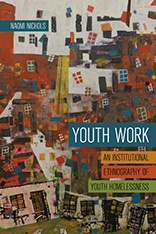As the post-doctoral fellow for the Canadian Observatory on Homelessness, I get the chance to focus almost full-time on developing and implementing a change-oriented research agenda. For me, this past year has been a chance to start to strategically pull together the various threads of my research in support of changes to the way we work with young people who are systems-involved and who get described as “at-risk” (of homelessness, school failure, involvement in the drug and sex trades, drug mis-use, and so forth).
 I want to use this blog space to discuss a new area of research that I am envisioning. This research will bring together my previous work in the area of youth homelessness (check out my first book: Youth Work: An Institutional Ethnography of Youth Homelessness coming out this August through the University of Toronto Press!), my research on systems-level responses to homelessness, and my research on community safety.
I want to use this blog space to discuss a new area of research that I am envisioning. This research will bring together my previous work in the area of youth homelessness (check out my first book: Youth Work: An Institutional Ethnography of Youth Homelessness coming out this August through the University of Toronto Press!), my research on systems-level responses to homelessness, and my research on community safety.
I am the Principal Investigator for a five-year community based research project on community safety. We are just wrapping up year one with a summer participatory research with young people who have been involved (or are still involved) with the Youth Justice system. One of the things we’ve discovered is that young people who live in Toronto Community Housing (TCH) have a lot more contact with the police. Further – and more unsettling – because they live in public housing, they don’t have the same rights and freedoms as someone who lives in a house or a non-subsidized apartment. This is because the Toronto Police Services (TPS) is authorized to be an Agent of the Landlord in all TCH buildings. The authorization means they can stop and question anyone on TCH property and the person has to give him/her their information. This type of data collection isn’t benign. The data is recorded on contact cards (the process is referred to as Carding) and is often used to generate crime analytics. My understanding is that the TPS also get unfettered access to TCH surveillance footage.
In “information led policing,” data guides police activity. So the data collected in these ways gets used to shape patrolling and stop patterns in neighbourhoods. These, in turn, shape who gets carded. It becomes almost like a cyclical process.
This year, I want to investigate how a young person’s interactions with the Justice System are shaped by experiences of housing insecurity, housing need, and homelessness. I also want to try to understand how race and ethnicity influence relations between housing and justice.
My sense is that the research will begin with an attempt to understand how young racialized men and women from stigmatized urban communities take care of their housing needs – with and without the support of families. From here, I want to investigate particular institutional junctures that research already suggests are problematic, such as the coordination of youth justice discharge and re-integration processes, particularly where families decide not to have a youth return home. I also want to know more about the police’s use of data collection procedures (e.g., carding process and the use of surveillance camera footage) in public housing environments, the practice of “kicking a youth out” to the streets as a disciplinary response used in families and the use of emergency shelters as institutional placements for “hard to house” youth.
If you want to learn more about this project, you can follow the research on Twitter @JnFResearch and Facebook at Jane and Finch Research in Motion where we'll share some of our findings as we go.

